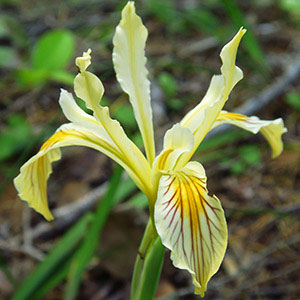Iris bracteata
Iris hookeri
Siskiyou iris
beach-head iris, iris de Hooker
sheathed with old leaf bases, slender, 0.6–0.9 cm diam.;
roots few, fibrous.
many-branched, forming dense, cespitose clumps with many crowded fans with persistent old leaf bases, 3–5 × 1.3–1.5 cm.
simple, solid, 1.5–3 dm.
several to many from a single clump of fans, simple, 0.5–6 dm.
basal with abaxial surface of blades deep glossy green on one side of fan, light yellow-green on other side, pink or red-tinged basally, strongly ribbed, 4–6 dm × 0.8–1 cm, rigid, margins not thickened;
cauline 3–6, imbricated, closely sheathing stem ca. 2/3 length, spreading distally, bractlike, blade inflated, often shorter than basal leaves.
basal erect or strongly ascending, blade 1–5.2 dm × 0.5–1.4 cm;
cauline 2–4, proximal 2–3 similar to basal leaves, distalmost leaf occasionally borne nearly midway on stem, clasping, blade bracteiform, lanceolate, 0.5–1.5 dm.
simple, units 1–2-flowered;
spathes closed tightly around pedicel and ovary, lanceolate, 5.2–9 cm × 6–8 mm, subequal, herbaceous, margins scarious, apex acuminate.
1–2-flowered;
spathes herbaceous, lanceolate to oblong-ovate, 2.5–6 cm, firm, outer spathe apex acute, inner similar or scarious at apex.
perianth cream to buff-yellow;
floral tube 0.8–0.9 cm;
sepals with deeper yellow signal, veined with purple or brown, obovate-lanceolate, 6.5 × 2.5 cm, base gradually attenuate into wide claw;
petals narrowly oblanceolate, 7–9 × 0.8–2 cm, base gradually attenuate;
ovary nearly circular in cross section, 1.5–2.5 cm, base gradually attenuate into pedicel, apex abruptly acuminate into floral tube;
style 2.2–3 cm, crests spreading, yellow, not veined, 1.2 × 0.9–1.7 cm, margins toothed;
stigmas triangular or tongue-shaped, margins entire;
pedicel 3–6.2 cm.
perianth deep to pale blue or blue-violet;
floral tube 0.5–0.75 cm;
sepals broadly rounded, 2.5–4 cm wide, base strongly attenuate to claw, signal diffuse white basal patch;
petals much reduced to insignificant, involute or tubular rudiments, 1–2 cm, apex with short bristle, mostly hidden by sepal bases;
ovary green or flushed purple, acutely trigonal;
style white with purple keel, 2–5 cm, crests overlapping, 2-lobed, subquadrate, margins coarsely serrate;
stigmas rounded-triangular, margins entire;
pedicel 2.5–4 cm.
nearly circular in cross section, tapering abruptly at each end, 2–2.5 × 1–1.5 cm.
thin walled, trigonal, with rounded angles and grooved sides, 2–4 cm, apex blunt.
dark brown, irregular in shape, wrinkled.
in 2 rows per locule, dark brown with prominent white raphe, compressed-pyriform, 4–6 mm, lustrous.
= 40.
= 38.
Iris bracteata
Iris hookeri
Iris bracteata is limited to one county each in northern California and southern Oregon. It hybridizes with I. chrysophylla, I. douglasiana, I. innominata, I. munzii, I. purdyi, and I. tenax.
(Discussion copyrighted by Flora of North America; reprinted with permission.)
Some authors still treat this taxon as Iris setosa var. canadensis, but others believe that it merits recognition as a separate species. I have seen I. hookeri flowering in its native habitat in both Nova Scotia and Prince Edward Island, and have examined dozens of herbarium specimens of both it and I. setosa, from which it is clearly distinct.
(Discussion copyrighted by Flora of North America; reprinted with permission.)


